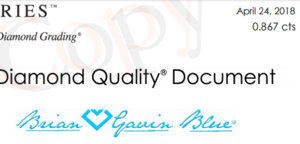mwilliamanderson
Brilliant_Rock
- Joined
- Aug 13, 2013
- Messages
- 1,223
I’ve noticed that some certificates such as those by AGS for Whiteflash and HP Diamonds state the brand of the diamond on the certificate. My own AGS certified JA True Hearts makes no mention of the brand and a recent purchaser @mvoila was wondering why Astor does not appear on his GIA certificate. Anyone know why this is? I know it’s not really needed...I’m just curious.










300x240.png)